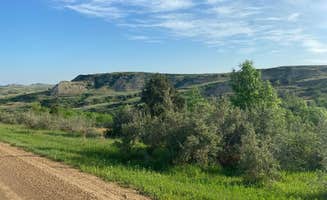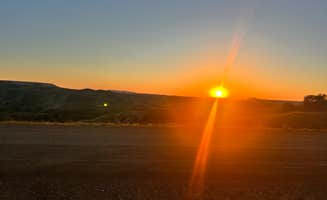Scoria Pit Dispersed Camping provides free camping near Grassy Butte, North Dakota, with multiple established sites located along a red rock road in the Little Missouri National Grassland. The elevation ranges between 2,300-2,700 feet with sites positioned across varying ridges. Summer temperatures typically reach 85-95°F with nighttime lows around 55-65°F, creating significant daily temperature swings that campers should prepare for.
What to do
Sunrise photography spots: The upper sites near the cell tower at Scoria Pit Dispersed Camping offer expansive panoramic views. According to one visitor, "Beautiful vistas all around. Medora is nearby with opportunities for dining & entertainment."
Evening stargazing: Clear nights reveal exceptional celestial viewing opportunities. One camper at Scoria Pit Dispersed Camping noted, "We got in at 11:30 PM and drove straight to the cell phone tower. Don't stop early; keep following the dirt road past what seems like the end. The panoramic vistas the next morning were incredible."
Wildlife viewing: Morning and evening hours provide opportunities to observe local wildlife. At West River Rd Medora ND Dispersed, one camper reported, "There was a large beautiful herd of feral horses bedding down with their little ones here in the evening though!"
What campers like
Uncrowded camping: The dispersed nature of sites allows for personal space without isolation. A camper at Scoria Pit shared, "Great place with lots of great spots to camp! Not cramped but not all alone."
Accessibility: The roads remain navigable for most vehicle types. A visitor noted, "After the first cattle guard, it's the first right! The coordinates might not be correct. If you cross a second cattle guard, you went too far."
Proximity to amenities: While no facilities exist at the dispersed sites, nearby locations provide basic services. A camper at Dispersed Site - Grassland Boondocking explained, "We were able to use all the facilities at the Painted Canyon Visitor center for morning rituals (aka teeth brushing bathroom in a toilet, face washing etc). We did drive to a Rough Rider State park for a shower which was $5 a person."
What you should know
Site availability: Competition for spots increases during peak season and weekends. One camper advised, "There is a lot of people looking for spots on a Monday. Get here early. It's worth it!"
Road conditions: Access roads vary in quality throughout the area. At Buffalo Gap Rd Dispersed Camp, travelers should note some sections require higher clearance vehicles, especially after rain.
Cell reception: Service strength varies by location and provider. A camper at Scoria Pit confirmed, "Lots of spots in a beautiful area. Good cell service as well."
Wind exposure: Sites on higher ridges experience stronger winds. One visitor cautioned, "Rooftop tent campers be aware the top ridge is so windy the first night we stayed we were whipping around all night but the second night we stayed on the lower ridge and the wind was much better."
Tips for camping with families
Arrival timing: Secure sites before nightfall for easier setup. A visitor recommended, "We arrived late, about 9:30 on Sunday evening and we were still able to find a spot. Beautiful place to watch the sunset."
Location navigation: Clear directions prevent frustration when locating specific camping areas. One camper at Camels Hump Lake advised looking for established fire rings to identify designated camping areas.
Level site selection: Finding flat terrain simplifies tent setup. A camper noted, "It was easy to get level and the views are incredible with an hours long sunset and very early sunrise."
Tips from RVers
Site spacing: The dispersed camping layout accommodates various vehicle sizes. One RVer at Patterson Lake Boat Ramp mentioned the availability of pull-offs large enough for medium-sized trailers and motorhomes.
Duration planning: Many visitors stay multiple nights to fully experience the area. A camper shared, "We stayed 2 nights in July in this area and it was great! Plenty of spots, so we didn't feel like we were on top of other campers."
Site exploration: Don't settle for the first available spot. A visitor suggested, "The coordinates are for the first spot. I don't know how many spots there are, but I just went until I found an empty spot."



